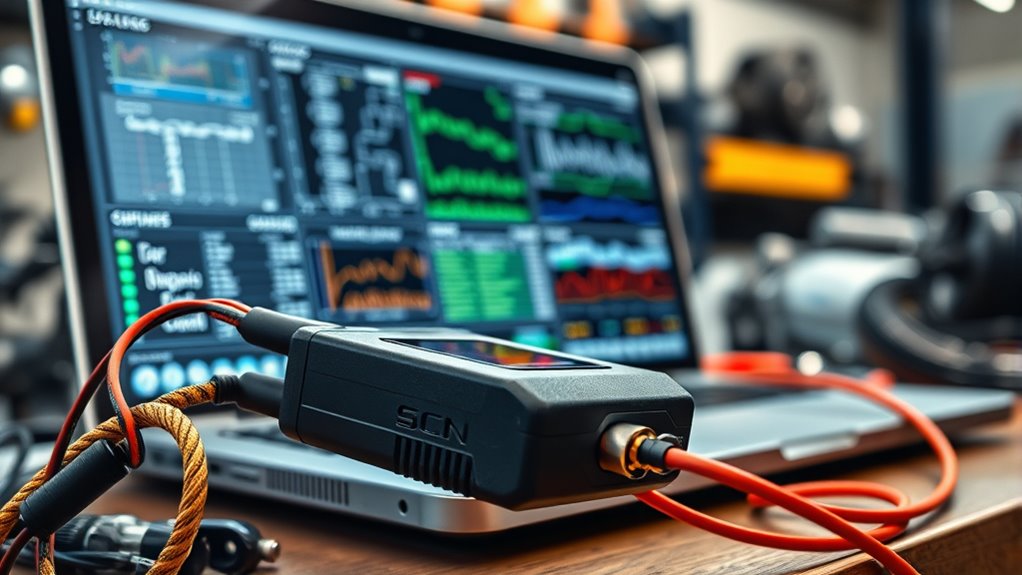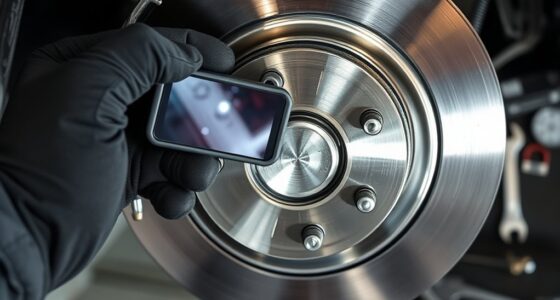Scan tool communication protocols are standards that let your diagnostic device connect and exchange data with a vehicle’s electronic systems efficiently. They guarantee smooth data flow, accurate diagnostics, and easy interpretation of trouble codes and parameters. Common protocols like OBD II and CAN bus provide universal compatibility across many makes and models. If you want to understand how these protocols work together to make vehicle diagnostics more reliable, keep exploring further.
Key Takeaways
- Communication protocols enable data exchange between scan tools and vehicle systems for diagnostics.
- OBD II standards define universal request, response formats, and DTC codes for compatibility.
- CAN bus architecture supports high-speed, multi-module communication within modern vehicles.
- Protocols ensure reliable retrieval of live data, ECU status, and fault codes across vehicle makes.
- Combining standards like OBD II and CAN enhances diagnostic accuracy and supports advanced vehicle monitoring.

A scan tool’s ability to communicate effectively with a vehicle’s electronic systems depends on the protocols it uses. These protocols ensure that data flows smoothly between the tool and the vehicle’s onboard computers, allowing you to diagnose and troubleshoot issues efficiently. One of the foundational standards in this domain is the OBD II (On-Board Diagnostics II) standards, which set the guidelines for communication across most modern vehicles. OBD II standards define how the scan tool requests data, how the vehicle responds, and the format of that data. They standardize diagnostic trouble codes (DTCs) and parameters, making it easier for you to interpret the information and identify problems. Essentially, OBD II acts as a universal language that helps your scan tool speak with a wide range of vehicles regardless of make or model.
Within this structure, the CAN bus architecture (Controller Area Network) plays a vital role. CAN bus is a robust, high-speed communication protocol that enables different electronic control units (ECUs) within a vehicle to exchange data efficiently. When your scan tool connects via the CAN bus, it taps into a network that links multiple systems—engine control, transmission, airbags, ABS, and more. This architecture allows for rapid data transfer and real-time monitoring, which is essential when diagnosing complex issues. Because CAN bus supports multiple message types and prioritization, your scan tool can access detailed information from various modules without overwhelming the network. This makes diagnostics faster and more extensive, giving you a clearer picture of what’s happening under the hood. Additionally, as the integration of AI in automotive technology advances, understanding these protocols can help you better utilize new diagnostic tools that incorporate AI-enhanced diagnostics.
Understanding how these protocols work together can greatly improve your troubleshooting process. When your scan tool adheres to OBD II standards and communicates over the CAN bus architecture, it guarantees compatibility and reliability. These protocols help you retrieve live data, read DTCs, and clear codes with confidence. Moreover, because CAN bus is widely adopted, most modern vehicles support it, making your scan tool adaptable across different brands and models. It’s also important to note that newer vehicles might incorporate additional protocols or even proprietary systems, but a solid grasp of OBD II and CAN bus provides a strong foundation for most diagnostic tasks.
Frequently Asked Questions
How Do Different Protocols Affect Scan Tool Compatibility?
Different protocols markedly impact your scan tool’s compatibility because protocol variations can cause compatibility challenges. When you use a scan tool, it must support the specific communication protocol of your vehicle’s onboard systems. If there’s a mismatch, the tool may not read data properly or connect at all. To avoid issues, make sure your scan tool is compatible with multiple protocols or tailored to your vehicle’s protocol requirements.
What Are the Security Risks Associated With Communication Protocols?
You might think your scan tool is as secure as Fort Knox, but encryption vulnerabilities and unauthorized access prove otherwise. These protocols often have weak spots that hackers can exploit, risking data breaches or malicious control over your vehicle. So, if you value your car’s secrets and safety, don’t ignore the security risks—because a breach today could turn into a costly repair tomorrow.
Can Protocols Be Updated or Upgraded Over Time?
Yes, protocols can be updated or upgraded over time. You typically do this through protocol versioning, which allows for new features and security enhancements. Firmware updates are essential in this process, as they help guarantee your scan tool remains compatible with the latest protocols. By regularly updating firmware, you can improve communication efficiency, fix vulnerabilities, and maintain security, keeping your diagnostic tools current and reliable.
How Do Protocols Impact Data Transfer Speeds?
Protocols directly impact data transfer speeds by influencing factors like signal latency and data encryption. When a protocol minimizes signal latency, data travels faster between your scan tool and the vehicle’s systems, improving performance. Strong data encryption ensures secure communication without appreciably slowing speeds. So, choosing efficient protocols helps you get quicker, safer data exchanges, enhancing your diagnostic process and reducing wait times during vehicle analysis.
Are There Universal Protocols That Work Across All Vehicle Brands?
There aren’t universal protocols that work across all vehicle brands due to differences in protocol standardization and diagnostic interoperability. You’ll find that many manufacturers develop proprietary protocols, which can limit compatibility. To guarantee accurate diagnostics, you might need multiple scan tools or adapters designed for specific brands. While some protocols like OBD-II aim for broader compatibility, they don’t cover every vehicle, making cross-brand diagnostics challenging.
Conclusion
Now that you understand the different scan tool communication protocols, imagine the possibilities as you unlock deeper insights into vehicle diagnostics. Each protocol is a key, revealing more about what’s happening under the hood. But with new technologies emerging, the landscape is constantly shifting. Will your skills keep pace? The future of automotive diagnostics is full of surprises, and only those prepared to adapt will truly master the secrets waiting to be discovered.









